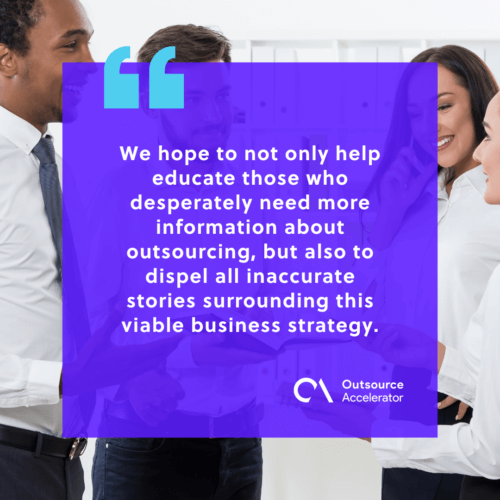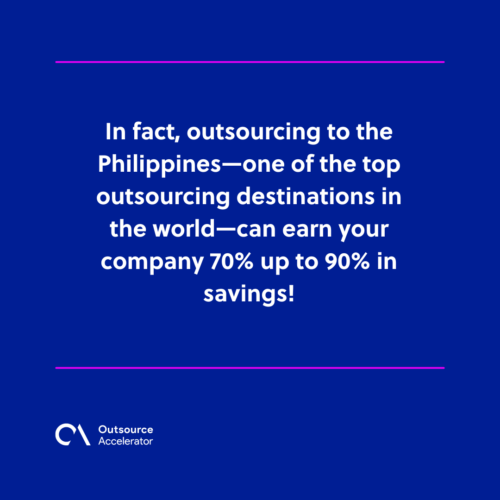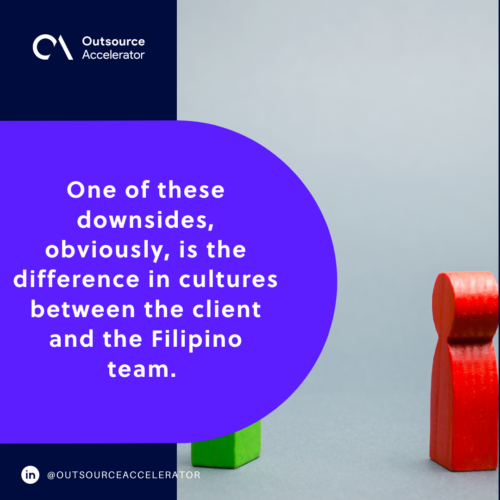The simple answer to outsourcing

Many people consider outsourcing as something of a mystery and wish to know more about it. Unfortunately for them, a lot of myths and misconceptions about outsourcing and overcomplicated explanations about how it’s done are floating on the internet. These only serve to confuse people rather than enlighten them.
This article is meant to settle once and for all what outsourcing really is. In doing so, we hope to not only help educate those who desperately need more information about outsourcing, but also to dispel all inaccurate stories surrounding this viable business strategy.
Outsourcing in a nutshell
So what really is outsourcing? Simply put, it’s the practice of hiring an outside individual or group of individuals to do a specific task for your business. Traditionally, the outsourced task or tasks are performed internally, either by you, the business owner, or by your employees. Some examples of the tasks that are often outsourced include the following:
- Finance and accounting
- Human resources
- Customer support
- Payroll
- Digital Marketing
- Office cleaning and maintenance
If it’s starting to sound similar to hiring someone temporarily or on a contractual basis, then you already have a basic idea of what outsourcing really is. There is just one caveat, though: in the context of this article, the kind of outsourcing we want to talk about is the kind that involves hiring a group of individuals to perform a specific business process for you offsite, such as in another country entirely. The concept itself is the same, except that the team handling your outsourced business functions is situated far away from your own office.

With this definition of outsourcing firmly in mind, we must then ask:
Why are businesses so scared of outsourcing?
Outsourcing can be a frightening concept for companies, especially those that have fallen prey to many misleading articles about outsourcing and so-called “experts” with very biased opinions. It’s a lamentable thing to behold, as the companies most skittish about this business strategy are often among those that stand to gain the most through it. Such benefits include saving up to 70% in overhead and salary costs and driving innovation and company growth.
But what exactly is the reason for this fear?
We believe that it’s due mainly to a lack of knowledge. Companies without access to credible and well-balanced information about outsourcing don’t feel confident about giving other people the responsibility of handling their business processes. This information gap breeds unfamiliarity and discomfort, causing many companies to become hesitant about even considering outsourcing as a viable business solution.
Without proper knowledge, business owners or decision makers may think of all sorts of reasons and worst case scenarios to further dissuade themselves from trying outsourcing. They may even start making up excuses as to why they should widen the gap in the first place, such as:
- “The geographical and time differences are too much of a bother to adjust to.”
- “Our cultural differences might be too insurmountable to work through and could result in a lot of wasted time and resources.”
- “Differences in laws and regulations between our countries can cause legal trouble for my staff or company.”
- “The language barrier may prove to be too challenging to work through and cause a lot of misunderstandings or awkward moments.”
- “Outsourcing work to another country could open up my company to unforeseen security risks I may not be prepared to deal with.”
Or, the decision makers—particularly those in small to mid-sized enterprises—can simply assume that outsourcing is too complicated and complex. With such a decision, they are missing out on the invaluable benefits that outsourcing could bring. The gap not only remains uncrossed but grows ever wider, with other companies lamentably following suit.
What makes the above scenario all the more tragic is that the outsourcing industry can adequately answer and address all these fears, doubts, and uncertainties.
The reason for this is simple: outsourcing is a tried and tested business strategy that has existed for more than a quarter of a century now. This business solution, as a whole, has evolved and refined itself enough during that period that any company nowadays would find it very easy and convenient to adopt outsourcing. There are guidelines, systems, and technologies in place to facilitate a smooth working relationship between clients and providers. What’s more, stakeholders are consistently and continuously innovating and collaborating to make the industry future-ready.
Companies with access to the right information about outsourcing will realize that they’ve been avoiding such a ripe opportunity for profit and growth for nothing. After all, if outsourcing were so risky and unpredictable as many companies have been led to believe, then would it have grown into a hugely profitable industry, with a global market value of US$88.9 billion in 2017? Of course not.
To dispel the fear that’s holding companies back from outsourcing, the knowledge gap must be crossed. This is what we are striving to do with this article, along with all of our other informative efforts thus far.

Outsourcing: not all that different from recruitment
As we posited earlier, outsourcing is very similar to hiring a contractor or contractual employee, in that a company employs an outside entity to render services for an agreed amount of time and resources. The only difference here is that instead of just an individual, the company is hiring an entire firm or company: one with its own name, policies, employees and facilities.
Don’t let the difference in scale distract you as a company owner. The same principles involved in the employee hiring process – principles that you should be very familiar with by now – can still be applied in choosing an outsourcing partner, despite the difference in scale. These principles include the following:
- Making sure that the candidate is culturally compatible with your company, with obvious passion for the work they do and the right skillset that you need.
- Training and supervising them carefully after hiring while exposing them to your company’s processes, values, and beliefs, in order to set expectations and make them accustomed to your company’s processes.
- Overseeing their work, giving feedback, and correcting their performance or output as you see fit.
As we can see, making outsourcing work for your company is not that different from ensuring that your newly-hired employee will turn out to be an asset for your business. The difference that companies will appreciate the most is that offshore outsourcing will be much more economical than hiring locally. In fact, outsourcing to the Philippines—one of the top outsourcing destinations in the world—can earn your company 70% up to 90% in savings!
If you find yourself still in doubt as to how safe and risk-free outsourcing is, think back on the last time you hired a local agency or business to render services for your company. Was it the local plumbing service, after you discovered that you had a leaky faucet or clogged toilet in need of fixing? Perhaps you made an arrangement with a cleaning agency for someone to come over your office every week or so. Maybe you’ve scheduled a local office supplies distributor to deliver office supplies direct to your office every other month or so.
Believe it or not, those incidents are perfect examples of a company utilizing outsourcing for its own purposes. You just didn’t know they counted as outsourcing to begin with. So yes, outsourcing is that reliable, easy, and commonplace. Hire a company from a location that offers high-quality but highly affordable labor, like the Philippines, and you’ve got a foolproof way to make your processes more efficient and economical but without compromising the growth of your company.

Outsourcing to the Philippines: easier than you think
So how does a company start the outsourcing process, especially when it involves working with a firm or agency that’s located outside your country or base of operations? Is it as complex as it seems, seeing as international business laws are involved, along with other potential complications?
It’s not complicated at all. Looking for and connecting with the right outsourcing partner can take a little work, but the process itself is quite straightforward. Remember, the outsourcing industry has been around for more than 25 years. That’s more than enough time for the major players to get their acts together and make it very easy for new clients to use their services. There is no need to start from scratch—there are many agencies and companies that can immediately take on the work that you need done.
BPOs or business process outsourcing firms take it upon themselves to improve their systems in order to better accommodate the needs of their clients. It is still a requirement for clients to carefully go over their contract before committing to a service provider, but they won’t need to sweat the small stuff. Many important details—like local tax and business laws compliance, staff concerns, utility bills, office leasing matters—will be handled by the BPO itself. This allows the clients to focus on the task that actually matters to them: managing the outsourced team properly.
A bigger fish to fry: effective team management as main concern
Companies that don’t have much experience with outsourcing are prone to worrying too much about procuring their outsourced team, which distracts them from managing the team properly and maximizing the strengths of their outsourced staff. As outsourcing experts and consultants, we have personally seen many business owners assume that their work is done once they’ve signed a contract with a BPO provider. Unfortunately, these same clients often fail to realize that, to maximize their latest investment, they also need to conduct proper training and instruction, business process mapping, and integration, and they need to set the expectations of their in-house and outsourced staff.
Again, outsourcing is very similar to how your company hires a contractor. Using the services of contractual workers is an economical and sustainable choice. But just like any other human resource, these outsourced workforce still require training, instruction, and supervision to truly flourish in their new roles. More than this, they also need enough time to properly adapt and acclimatize to their role in the company. Without proper preparation, your outsourced team may not be able to perform their tasks to the best of their abilities, and your company will not be able to maximize the team’s productivity and efficiency.
The downsides of outsourcing
The benefits of outsourcing business processes to the Philippines are numerous and significant. Through careful planning and supervision, any company can maximize these benefits to truly grow their operations. By the same token, there are downsides to outsourcing to this country that also need to be taken into consideration. In doing so, a company can cement their relationship with their Filipino outsourced team and avoid any potential mishaps.
One of these downsides, obviously, is the difference in cultures between the client and the Filipino team. Filipinos, for instance, absolutely detest being criticized or called out in public. They will suffer it quietly, but rest assured they will take offense to any instance of public shaming. It’s best to deliver criticism in private. This allows the Filipino employee to take the feedback seriously without losing face among their coworkers.
Another potential sticking point that needs to be navigated carefully is the Filipino’s innate desire for a rigid and defined hierarchy in the company, as well as a well-defined role. They work better when they know their immediate superiors and who they need to report to or consult if they find themselves confused or stuck in their roles. One suggestion is to assign an in-house staff as a point of contact during the contract period – the team’s de facto “boss”.
This is not to say that the client needs to walk on eggshells around their outsourced team. Filipinos by nature are very understanding and very hardworking employees, and they are known to take great pride in a well-done job. However, as differences still exist, clients are advised to keep an open mind when approaching or dealing with their outsourced team. This way, any misunderstandings can be easily resolved, understood, and learned from.
To know more about dealing with the specific challenges of working with a Filipino outsourced team, read our article “How to Get the Best Out of Your Filipino Workforce”.

Avoiding filters: communicating with your outsourced team
When it comes to communicating with employees, nothing is as effective as face-to-face communication. The receiver understands the message clearly and comprehends the additional context and nuance of the message through the speaker’s tone of voice, expressions, body language and more. With this method, the entirety of the message is absorbed and comprehended perfectly.
Unfortunately, outsourcing clients do not have that luxury and they often have to resort to cold and impersonal ways of communication like e-mail and chat in order to get their points across to their outsourced team. Important elements in face-to-face communication are stripped when these methods are used, so there is a high possibility that the message itself will neither be understood in full nor followed to the letter. It may even sow confusion among the team, which can then turn into frustration. This is what we can call a ‘filter’ effect on communication, and it happens when important details are removed from the conversation.
Of course, there are other and more personable ways of communicating, all thanks to rapid technological advances. Chat and e-mail can be supplemented with phone calls or even video conferences, allowing the receiver to hear and see the person delivering the message. The filter may still be there but it will be reduced in such a way that both parties will understand each other.
Culture can also serve as a filter, and cultural differences can cause people to misinterpret what the other person is saying. Both the client and the provider must meet halfway and become more aware of each other’s culture, habits, and language to understand each other well. These filters will not be in place for too long. The filter will gradually go away as both sides get used to each other’s differences during their contract period, resulting in a cohesive and productive relationship that’s bolstered by genuine communication.
Finally, there’s the reassuring fact that even companies that do not dabble in outsourcing may experience these very same challenges, especially when it comes to non-traditional working setups, like allowing employees to work from home or in remote locations. These work setups still allow companies to remain fully functional and even more productive, so it shouldn’t pose problems for companies that are considering outsourcing.
Conclusion
Outsourcing may seem like a very complicated and complex subject but it’s actually a lot simpler than many so-called experts and sources think. At the very least, we hope that this article has given you a clear and concise explanation about the topic, and that you now have a good foundational knowledge about this business strategy—enough for you to confidently discern outsourcing facts from fiction.
If you need more practical information and news about outsourcing, Outsource Accelerator offers a wealth of information in the form of articles, white papers, and ebooks. Start with our podcast series and hear directly from outsourcing clients, providers, and experts who are deeply immersed in the industry.







 Independent
Independent




